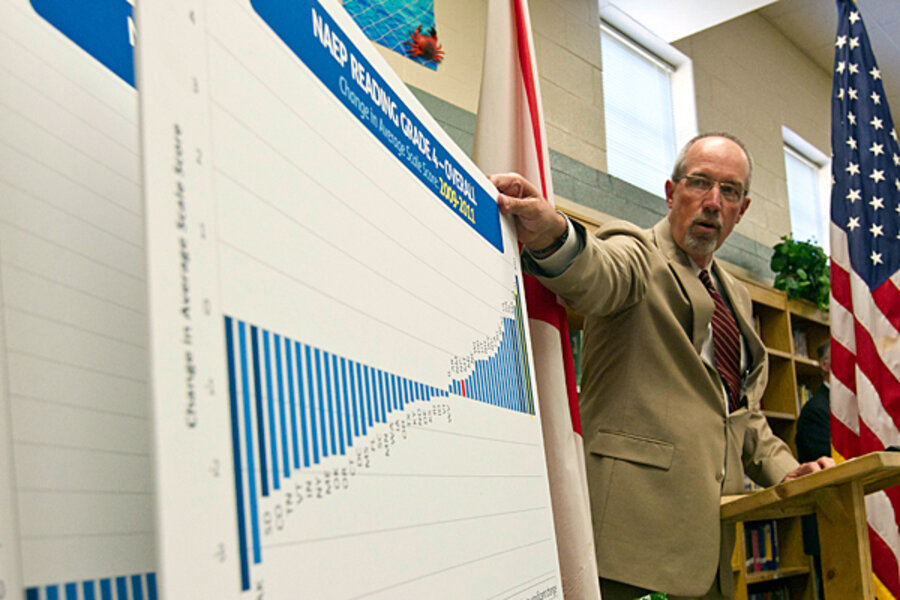Education report card: Flat reading scores are 'deeply disappointing'
America’s fourth- and eighth-graders are inching ahead in their performance in math, but their reading scores are largely stagnant.
That’s the verdict from the latest round of data from the National Assessment of Educational Progress (NAEP), otherwise known as the “nation’s report card,” which regularly measures students’ performance on a variety of subjects.
The best news from the 2011 test was in math, where scores have risen steadily since 1990. The scores posted a small increase from 2009, the last time the test was given. For fourth-graders, the average math score was 241 on a 500-point scale – 28 points higher than in 1990 and 1 point higher than in 2009. Students at all percentiles except the lowest one increased.
In reading, the progress has been far slower and seems to have stalled out in fourth grade. Students at that level showed no improvement since 2009, and their scores were just four points higher than in 1992. (Eighth-grade scores were one point higher than in 2009 and five points higher than in 1992.)
In both math and reading, fairly few students are reaching the “proficient” level set by NAEP – just over a third of students in reading and in eighth-grade math, and 40 percent of students in fourth-grade math. Still, that level represents a considerable improvement over time in math.
“The modest increases in NAEP scores are reason for concern as much as optimism,” said Education Secretary Arne Duncan in a statement. “It’s clear that achievement is not accelerating fast enough for our nation’s children to compete in the knowledge economy of the 21st Century.”
The NAEP scores also highlight achievement gaps for minority and low-income students, which have been slow to narrow.
There was no change in the black-white achievement gap in either reading or math between 2009 and 2011, although there was a small improvement in the Hispanic-white gap for both eighth-grade reading (where the 22-point gap was two points smaller than in 2009) and eighth-grade math (where the gap narrowed three points, to 23).
“Overall, we see patterns of some improvement over time, and some gap narrowing over time, and that’s a good thing. And it’s a testament to the hard work going on between teachers and students in classrooms day in and day out, but it’s not nearly fast enough,” says Daria Hall, director of K-12 policy for the Education Trust, which focuses on narrowing the achievement gap for poor and minority students.
Ms. Hall points to individual schools and districts that have made big strides toward erasing that gap. The things that have worked in those places – particularly attracting better teachers and improving the curricular and leadership support for those teachers – need to be implemented more systemically, she says.
Others note that the seeming intractability of the achievement gaps don’t tell the whole story, since overall scores have been improving – particularly in math – for black and Hispanic students over time, along with white students' scores.
“The hidden story in just looking at the achievement gap is that you can have both groups going up” and not show a narrowing of the gap, says Jack Jennings, president of the Center on Education Policy, a nonpartisan research group in Washington.
“There are two positive stories” in this year’s NAEP scores, he says: “We are still making progress in math. We’re nowhere near where we ought to be, but at least we’re on an upward trajectory. And the two largest minority groups in the country are doing better in both reading [at the eighth-grade level] and math.”
But if math is showing a steady, if slow, improvement, reading trends have been far flatter.
David Driscoll, chairman of the National Assessment Governing Board, called the lack of change at the fourth-grade level “deeply disappointing.” Those scores have been flat for four years, he noted.
“Over the past two decades major gains have occurred in mathematics achievement, but only modest improvements in reading,” Mr. Driscoll said in a statement. “We must now find a way to regain the momentum in math and accelerate student progress in both subjects.”
Driscoll and others noted that reading, in some ways, has been tougher for schools to address since – unlike math – so much of reading is learned at home or across disciplines.
At the announcement of results, Doris Hicks, a member of the governing board and principal of a New Orleans charter school, spoke about the reading results, saying that she saw the flat performance as “losing ground.”
“We need to emphasize higher-order thinking skills when it comes to reading,” Ms. Hicks said, pushing comprehension over simple regurgitation. "Another key is taking a holistic approach,” including involving families, she added.
She talked about the many ways her school focuses on reading, including constant efforts to get kids excited about reading and “literacy blocks” – a period that focuses on phonics, fluency, comprehension, and vocabulary.





